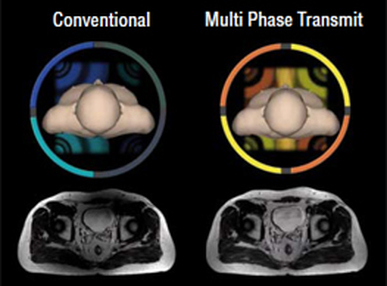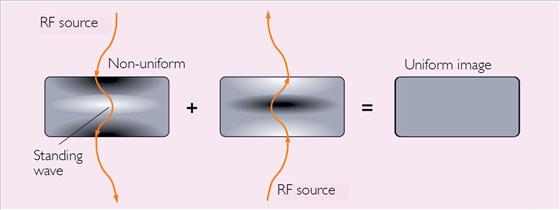|
|
Multi-transmit or parallel transmission technology is one of the most exciting recent developments in MRI. In many ways it is the natural extension of widely used parallel receiver imaging applied to optimize properties of the transmitted (B1) field.
The basic idea is relatively simple: instead of the entire RF coil transmitting a single B1 field, divide the coil into separate independently powered and controlled elements that each produce their own B1 subfields. The sum of these subfields constitutes the net B1 field experienced by the tissue. In this manner it is possible to more carefully control the homogeneity of RF excitation as well as the distribution of magnetic and electric fields produced in tissue. |

All RF-transmitters are synchronized with sub-nanosecond precision and each channel is driven by its own solid state RF-amplifier. Each channel has its own transmit/receive (T/R) switch to allow bimodal operation if desired. Alternatively, the resonator can be operated purely in transmit mode with separate surface coils used as receiver elements.
An amplifier shutdown unit is required to avoid potentially hazardous increase in tissue heating should a single channel fail. Circulators are needed to protect amplifiers against reflected or coupled power from coil elements.
Prior to imaging a calibration sequence (typically a 3D gradient echo field phase mapping technique) is required to to optimize the power, amplitude, phase and waveforms of the individual RF sources to each patient’s anatomy. This process is called adaptive RF-shimming. Notwithstanding the time involved in this calibration, total imaging times with 2-channel RF systems may be reduced on certain high specific absorption rate (SAR) sequences by 30% or more by allowing more slices per TR.
Advanced Discussion (show/hide)»
Further comments on parallel transmit RF....
In addition to TEM resonators, a variety of interesting new coil designs exist optimized for parallel transmit technology. These include stripline and shielded loop arrays. Other advanced modifications to TEM and birdcage resonators include the use of "active rungs" which can be controlled individually by embedded electronic elements.
At present, commercial systems (Siemens, Philips, Toshiba) offer dual transmit systems commercially, but many 8-transmit systems and even higher have been prototyped, so you can expect higher order systems in the future.
We are really just at the beginning of this new phase of MR technology. Careful control over the RF through multi-transmit techniques will open up new vistas including tailored RF's matched to individual patients, pulse sequences, and even to individual points in k-space! Three-dimensional RF stimulation is also possible.
Brink WM, Gulani V, Webb AG. Clinical applications of dual-channel transmit MRI: a review. J Magn Reson Imaging 2015; 42:855-869.
Grissom WA, Sacolick L, Vogel MW. Improving high-field MRI using parallel excitation. Imaging Med 2010; 2:675-693.
Harvey PR, Hoogeveen RM. Multi transmit parallel RF transmission technology. Philips Healthcare. 2009.
Katscher U. Basic and tailored RF shimming in a multi-transmit whole body MR system. PIERS Online, 2008; 4(7):781-784.
Wald LL, Adalsteinsson E. Parallel transmit technology for high field MRI. Siemens Medical Systems, Magnetom FLASH, 2009; January:124-129.
Webb AG, Collins CM. Parallel transmit and receive technology in high-field magnetic resonance neuroimaging. Int J Imaging Syst Technol 2010; 20:2–13.
What is the purpose of radiofrequency (RF) coils?
I don't understand all the different types of coils in MR. Can you make sense of these?
What are TEM coils?
What is a birdcage coil and how does it work?


